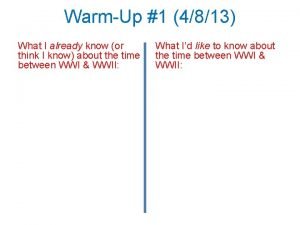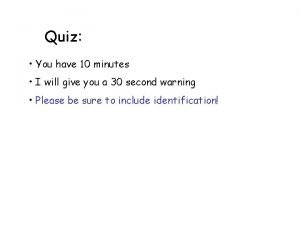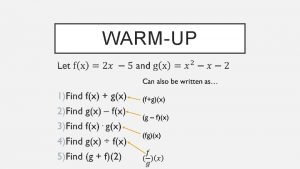WarmUp 4813 WarmUp Solutions Quiz n You have


















- Slides: 18

+ Warm-Up 4/8/13

+ Warm-Up Solutions

+ Quiz n You have 15 minutes to finish your quiz. n When you finish, turn it in, pick up a guided notes sheet, and wait quietly for your classmates to finish.

+ Chapter 10: Estimating with Confidence Section 10. 1 Confidence Intervals: The Basics

In Chapter 9, we learned that different samples yield different results for our estimate. Statistical inference uses the language of probability to express the strength of our conclusions by taking chance variation due to random selection or random assignment into account. In this chapter, we’ll learn one method of statistical inference – confidence intervals – so we may estimate the value of a parameter from a sample statistic. As we do so, we’ll learn not only how to construct a confidence interval, but also how to report probabilities that would describe what would happen if we used the inference method many times. Confidence Intervals: The Basics Our goal in many statistical settings is to use a sample statistic to estimate a population parameter. In Chapter 4, we learned if we randomly select the sample, we should be able to generalize our results to the population of interest. + n Introduction

The Mystery Mean The following command was executed on their calculator: mean(rand. Norm(M, 20, 16)) The result was 240. 79. This tells us the calculator chose an SRS of 16 observations from a Normal population with mean M and standard deviation 20. The resulting sample mean of those 16 values was 240. 79. Your group must determine an interval of reasonable values for the population mean µ. Use the result above and what you learned about sampling distributions in the previous chapter. Share your team’s results with the class. Confidence Intervals: The Basics Your teacher has selected a “Mystery Mean” value µ and stored it as “M” in their calculator. Your task is to work together with 3 or 4 students to estimate this value. + n Activity:

Intervals: The Basics A point estimator is a statistic that provides an estimate of a population parameter. The value of that statistic from a sample is called a point estimate. Ideally, a point estimate is our “best guess” at the value of an unknown parameter. We learned in Chapter 9 that an ideal point estimator will have no bias and low variability. Since variability is almost always present when calculating statistics from different samples, we must extend our thinking about estimating parameters to include an acknowledgement that repeated sampling could yield different results. Confidence Intervals: The Basics Definition: + n Confidence

Idea of a Confidence Interval To answer this question, we must ask another: Confidence Intervals: The Basics Recall the “Mystery Mean” Activity. Is the value of the population mean µ exactly 240. 79? Probably not. However, since the sample mean is 240. 79, we could guess that µ is “somewhere” around 240. 79. How close to 240. 79 is µ likely to be? + n The

+ Warm-Up 4/9/13

+ Warm-Up Solutions

Idea of a Confidence Interval + n The Confidence Intervals: The Basics If we estimate that µ lies somewhere in the interval 230. 79 to 250. 79, we’d be calculating an interval using a method that captures the true µ in about 95% of all possible samples of this size.

Idea of a Confidence Interval Definition: A confidence interval for a parameter has two parts: • An interval calculated from the data, which has the form: estimate ± margin of error • The margin of error tells how close the estimate tends to be to the unknown parameter in repeated random sampling. • A confidence level C, the overall success rate of the method for calculating the confidence interval. That is, in C% of all possible samples, the method would yield an interval that captures the true parameter value. Confidence Intervals: The Basics estimate ± margin of error + n The We usually choose a confidence level of 90% or higher because we want to be quite sure of our conclusions. The most common confidence level is 95%.

Interpreting Confidence Levels and Confidence Intervals Interpreting Confidence Level and Confidence Intervals Confidence level: To say that we are 95% confident is shorthand for “ 95% of all possible samples of a given size from this population will result in an interval that captures the unknown parameter. ” Confidence interval: To interpret a C% confidence interval for an unknown parameter, say, “We are C% confident that the interval from _____ to _____ captures the actual value of the [population parameter in context]. ” Confidence Intervals: The Basics The confidence level is the overall capture rate if the method is used many times. Starting with the population, imagine taking many SRSs of 16 observations. The sample mean will vary from sample to sample, but when we use the method estimate ± margin of error to get an interval based on each sample, 95% of these intervals capture the unknown population mean µ. + n

Interpreting Confidence Levels and Confidence Intervals The confidence level does not tell us the chance that a particular confidence interval captures the population parameter. Instead, the confidence interval gives us a set of plausible values for the parameter. We interpret confidence levels and confidence intervals in much the same way whether we are estimating a population mean, proportion, or some other parameter. Confidence Intervals: The Basics The confidence level tells us how likely it is that the method we are using will produce an interval that captures the population parameter if we use it many times. + n

a Confidence Interval When we calculated a 95% confidence interval for the mystery mean µ, we started with estimate ± margin of error This leads to a more general formula for confidence intervals: statistic ± (critical value) • (standard deviation of statistic) Confidence Intervals: The Basics Why settle for 95% confidence when estimating a parameter? The price we pay for greater confidence is a wider interval. + n Constructing

a Confidence Interval The confidence interval for estimating a population parameter has the form statistic ± (critical value) • (standard deviation of statistic) where the statistic we use is the point estimator for the parameter. Properties of Confidence Intervals: § The “margin of error” is the (critical value) • (standard deviation of statistic) § The user chooses the confidence level, and the margin of error follows from this choice. § The critical value depends on the confidence level and the sampling distribution of the statistic. § Greater confidence requires a larger critical value § The standard deviation of the statistic depends on the sample size n Confidence Intervals: The Basics Calculating a Confidence Interval + n Calculating The margin of error gets smaller when: ü The confidence level decreases ü The sample size n increases

Confidence Intervals 1) Random: The data should come from a well-designed random sample or randomized experiment. 2) Normal: The sampling distribution of the statistic is approximately Normal. For means: The sampling distribution is exactly Normal if the population distribution is Normal. When the population distribution is not Normal, then the central limit theorem tells us the sampling distribution will be approximately Normal if n is sufficiently large (n ≥ 30). For proportions: We can use the Normal approximation to the sampling distribution as long as np ≥ 10 and n(1 – p) ≥ 10. 3) Independent: Individual observations are independent. When sampling without replacement, the sample size n should be no more than 10% of the population size N (the 10% condition) to use our formula for the standard deviation of the statistic. Confidence Intervals: The Basics Before calculating a confidence interval for µ or p there are three important conditions that you should check. + n Using

+ Homework n. Textbook n#s: pg. 640 -641 10. 19, 10. 21, 10. 22, 10. 23
 I have chosen you and not rejected you
I have chosen you and not rejected you Warmup ratio
Warmup ratio Warmup 65
Warmup 65 Gmass warmup
Gmass warmup Stratified warmup
Stratified warmup Surface area warm up
Surface area warm up Rhyme glow
Rhyme glow Multiplying with exponents
Multiplying with exponents Java warmup
Java warmup Define:warmup
Define:warmup Pathos story
Pathos story Tinman calculator
Tinman calculator 65 mins
65 mins Warmup end
Warmup end Prism with 12 faces
Prism with 12 faces If you had studied hard you wouldn't failed the exam
If you had studied hard you wouldn't failed the exam How to paraphrase a quote
How to paraphrase a quote You must unlearn what you have learned
You must unlearn what you have learned The triangle shirtwaist factory fire commonlit answer key
The triangle shirtwaist factory fire commonlit answer key



































